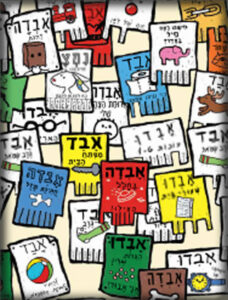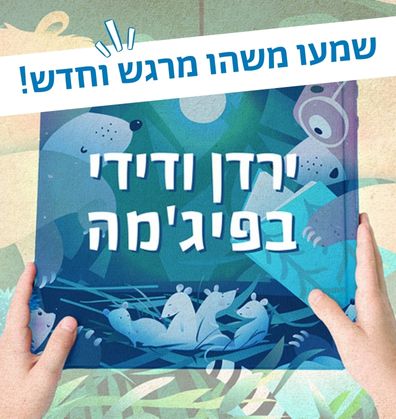מִשְׁפָּחָה וּקְהִלָּה
חברות
כבר מגיל צעיר מתנסים ילדים וילדות ביצירת קשרים וחברויות דרכם הם מפתחים מיומנויות בין-אישיות כמו שיתוף, התחשבות ואמפתיה, וחווים אהבה, תמיכה ושמחה. בחברות, כמו בכל מערכת יחסים, ישנם כמובן גם אתגרים וקונפליקטים כמו בכל דבר בחיים. בעזרת ספרים על חברות אפשר לגעת בנושאים שונים כמו ערכה של החברות והתמודדות עם אתגרים שבין חברים, ולעורר שיח רגשי על נושאים יום יומיים שמעסיקים ילדים וילדות בגיל הרך.
סְּפָרִים
Book-Related Family Activities

Fighting and Reconciling
Talk with your children and ask: How do you feel when you fight with a friend or family member? How do you both behave during a quarrel? Can anything help you reconcile? How can we help friends who are fighting reconcile?
QR code
Scan the code to listen to a special episode on quarreling from the podcast Yarden and Didi in Pajamas.

Making Peace
This book can inspire you to take two puppets, toy cars, or any pair of items; you can even put a pair of socks on your hands. Invite your children to imagine and make up a “real fight” – what are they fighting about? How do they reconcile? Do they reconcile on their own or do they need help doing so? Now you are ready to put on a show.

Exploring and Discovering
Hyraxes and ibexes are desert animals that live in Israel. This book provides a wonderful opportunity to explore and discover! What do they look like in real life? What characterizes them? What do they enjoy eating? What other interesting facts would you like to know about them?

Arts & crafts, songs, and other activities can be found on the Sifriyat Pijama Pinterest page.

Family reading advice
Illustrations are an integral part of books, completing details that are not always found in the text itself. For instance, the building blocks Taylor uses only appear in the illustrations. Did you discover any other details through the illustrations? Sometimes, it’s worth trying to read a story “over again” using the illustrations and seeing what else we can discover about.

Discussion – When things fall apart
Sometimes, things we put a lot of time and effort into fall apart or fail. We can discuss that by asking – Has anything similar to what happened to Taylor ever happened to you? How did you feel? When you’re upset or frustrated – what helpscheer you up? Which of the animals in the book would you have called out to for help?


Listening exercises
Listening exercises can help us sharpen our senses and notice new things: Try speaking to one another while sitting back-to-back, and then face-to-face. How did you feel each time? Another exercise is: Close your eyes for one minute, be completely silent and still, and try only to listen to the sounds around you. When the time is up, tell the others what you heard.

Animal mimicking
What does the ostrich look like when it buries its head in the sand? What does the elephant do with its trunk when it remembers? And what does the bear look like when it is angry? Try mimicking each of the animals in the book by copying its movements, sounds and suggested solutions.

Family reading advice
Books that describe familiar experiences in children’s lives are an opportunity for a glimpse into their world. While reading, you should pay attention to what the children notice most, the questions they ask, and the characters with which they identify. Sometimes, books make it easier to discuss things that happen in real life.

Discussion – Joining the game
Discuss with and ask the children: how do you think Birt felt when Shu joined their game? Have you ever played with a friend and had another person ask to join in? Have you ever asked to join other children?
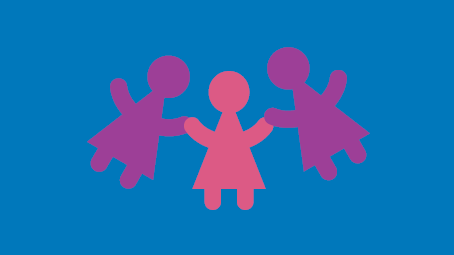
Arts & crafts with friends
Good friends can make a simple box into a palace, boat, or spaceship. You can suggest inviting one or several friends over for some joint arts & crafts time. Perhaps they will discover what else a box can turn into – with a little imagination, a pair of scissors, some markers, but most importantly – lots of togetherness.

Now Birt, then Shu, then Etho
Playacting is a great way of learning about the experience of others while expressing feelings and sensations. You can act this story out with the help of various family members or toys. Take turns playing each role, so that you can experience the story from the different characters’ perspectives.
Tip for Family Reading
Books featuring characters who are imperfect and make mistakes generate empathy, and enable a discussion on subjects that are not easy to directly address. Use this book to spark a discussion and ask questions about the characters’ actions and feelings to encourage your children to express their own inner thoughts and feelings.
Asking for Forgiveness
You may want to ask your children: “What did you think about what Chico said to Pilchas?” “Which situations may lead to a hurtful exchange?”. You can also discuss similar situations they had to deal with, and ask: “Have you ever said something you later regretted?”, “Did you say you were sorry?” “How did you feel afterwards?”
Watch & Learn!
What is the speed of sound that the rabbit was trying to achieve? This Davidson Institute of Science video will teach you all about it using a fun experiment with a sound pipe.

There are many ways to say I’m sorry
You can help Chico ask for Pilchas’ forgiveness in various ways – a letter, drawing, poem, or dance. “Helping” Chico will enable children to develop their own forgiveness-asking skills, and help fix situations even when they seem too hard.

Becoming Marksmen
You can be inspired by this book to have your own marksmanship competition. You can make a bow and arrow using sticks and elastic bands, or take turns shooting balls into a bucket. Don’t forget to decide which of the forest animals you are!

Tips for family reading
This is a special book that delicately addresses coping with a friend’s complex physical or emotional state. We recommend that parents read this book before reading it together with their child in order to adjust the reading and discussion to the book’s unique content, and the child’s unique world.

“And I found a way”
David’s friend immediately notices when David’s behavior changes. You can discuss and share: Have you ever noticed when someone you have been close began to act differently? What did you do? What do you think about what Davd’s friend did?

Paper flowers – a kind gesture and a good word
Invite your child to make a colorful floral crown that would bring joy to your family. Suggest that your child cut out paper flowers and decorate them, and then write a kind word about each .family member

A “just in case” box
What comforts and cheers you up during difficult times? A kind word? A touching book? Perhaps a toy? You can make a box filled with “just in case” ideas: Items that cheer you up, encouraging messages, and kind words.

A hug in a letter
Does your child have a friend or family member who is coping with a complex physical or emotional condition? You can suggest that your child write that friend or relative a letter of encouragement. Use supportive words, such as: I’m here for you; you’re strong; we’re your friends; and we love you. You can add a drawing that will put a smile on their face too.

Family reading advice
Books containing very few words allow us to tell an emotional and experiential story as we follow the main character in the book: What is he feeling? What is he thinking about? When is he sad and when does he get a new idea? You can look at the illustrations, get to know the main character and his experiences, link them to your own lives and, most of all, add something of yours to this experience that is being described in so few words and in heartwarming illustrations.

A gift of something
Did Mooch only give Earl an empty box for a gift? You can discuss gifts that cannot be put into boxes: Which free gifts can you give one another? A hug? A drawing? How about warm loving words?

A box of nothing
You can also have your own box of nothing. Take a box or paper bag, decorate it with paper, drawings, stickers and decorations. Whenever you are bored, open the box and use your imagination to decide what is in it: Maybe it contains an imaginary ball that you can pretend to toss between you, or an imaginary story that you have made up together, or any other invention with which you can come up.

Our books
Have you tried reading a book using a bird’s voice? Perhaps you happen to own a red book? Scan the code and you can play a game that encourages reading using the books you have at home. You can even get a certificate at the end of it!

Doing nothing
What happens when we do nothing? You should take a few minutes to sit quietly and listen. What can you hear? What can you see? What can you feel with your body? You can share your experience with your family and think together: Does nothing really happen when we do nothing?

Family reading advice – Sharing experiences
Many books describe toddlers’ daily challenges: difficulty sharing, difficulty parting, the challenging transition from daytime to nighttime, and many more. When identifying a challenge with which your toddler is struggling, choosing a book on the subject and reading it together can be a good idea. Books invite us to share our feelings and experiences, and can offer empathy, encouragement and coping ideas.
Lea Naor was born in 1935 in Herzliya. She has written books, plays, screenplays and children’s poetry, and has also translated many books into English, such as the Dr. Seuss series. Her books and translations have won her many awards.

What is mine and what is ours?
You can discuss the things that are shared by all family members as opposed to those that belong to each of you separately. For instance: “We each have our own toothbrush – what does your toothbrush look like?”, “We all share this house together, who lives in our house?”

Dramatizing and swapping
You can dramatize this book using stuffed animals and have fun together: Swap the toys between you along with the song, and in the refrain az tekhef nihye shutafim bekhol hadvarim hayafim (“so soon we will share all the beautiful things”), you can hold the toy together, and demonstrate sharing.
Illustrations and animals
A cat, a dove, a turtle, a puppy and a young bird – all in one book! You can look at the illustrations, choose an animal together, imitate the sound it makes and act just like it according to the description found in this book. For example, if you choose the turtle “with its entire house on its back” – you can place a cushion on your back and walk on all fours. And how does the puppy with the spot wag its tail?
A tip for family reading
You can find something to like in every book: The drama, the characters, or maybe the illustrations or interesting words. After reading the book, try asking the children what they liked about the story, and share what you, the parents, enjoyed. You can even tell each other which books you especially like and why.

Friends and us
Peetz and Morchella are spending time together. She’s growing vegetables and he’s nurturing them. In the meantime, they are chatting, singing, and simply enjoying their time together. You can ask the children what they like doing with friends. What do they do together? As parents, this is a good opportunity to reminisce with your children and share your experiences and memories with childhood friends.

Vegetables and drawings
Cabbage? Kohlrabi? – Thirteen types of edible vegetables appear in the book. Can you find them all? You may want to eat your favorite vegetables or try new vegetables.
Nice to meet you: the morchella
So, who are you, Morchella? If you scan the code, you’ll learn about the morchellas that sprout up in Israel each winter. Do you want to learn more? Go to the library together or surf the internet and look for information on morchellas and other mushrooms.
Growing vegetables
You can grow vegetables, even if you don’t have a plot of land. Try taking a cut carrot top, cloves of garlic, or the bottoms of lettuce or celery, and soak them in a transparent container with water. Wait patiently, add more water if needed, and little by little, you will see leaves and roots sprout. You can cut them off and eat them, or plant them in a flowerpot, and wait for new vegetables to grow. Don’t forget to water them!

Family reading advice
Children identify with the characters in the book, and acquire a better understanding of others who are different from them, thereby developing empathy and adaptability to new situations. While reading, you can focus on the characters’ facial expressions and ask: How do you think they feel? And why?

Discussion
You can discuss and ask: With whom and what do you like to play? In your opinion, what should we do when we each want to play a different game? What solutions can we suggest?
Annoying but also fun
Libby wants to join Pupik on his visit to the fire station, but he is annoyed – can a solution be found? Watch the video to find out!

Moving with the illustrations
Sitting, jumping, or perhaps bending down? Take turns choosing a page in the book, and showing the others a movement or posture similar to that of the characters depicted in the book. The other players can then imitate the movement, and look for it in the right page in the book. Did you find it? Then it is now time for the next player to choose a page.

The game of games
On separate notes, write down the games you like to play together: Hide-and-seek or maybe catch? Put all the notes in a box and choose one at random each day. What does it say? Would you like to play this game together? If not, you can always take another note out of the box or add a new note suggesting a new game.
A bit of advice when reading as a family
Toddlers like to be part of the story: Repeating words and sounds found in the book, or dramatizing the actions taken by the different characters. It is their way of identifying with the story, enriching their emotional worlds, and acquiring vocabulary and concepts. That is why, when reading together, you could “play” the trumpet, “beat” on a drum using your hands, and pretend you’re a choir conductor.
Playing music together
Almost any item can become a musical instrument: You could clap together to the rhythm of the song, or collect any instruments, rattles, and utensils you can find. A pot with spoons can be a drum, a used roll of paper towels can be a trumpet. You could even try to tap various materials to find out what kinds sounds tapping wood makes? And what about tapping the floor? Or metal? You may enjoy picking one of your favorite songs and playing it together.
Listening to the story
Please scan the QR code to listen to the story. You may enjoy turning the pages of your book as you do.
Dramatizing the story with toys
Your children’s favorite stuffed animals and other toy animals can also be part of the story: Add or omit one each time as you act the story out together.

Playing a game of ‘Who is sleeping under the blanket?’
Ask your toddlers to close their eyes, and hide a stuffed or other toy animal under the blanket. When they open their eyes, you, parents, can give them hints as to the identity of the hidden animal, until your toddlers guess what it is. Does it bark? Does it hop around and eat carrots? You could also switch roles, letting your toddlers give you, parents, hints about who is hiding there, underneath the blanket.
A discussion on being together and apart
Gali and Gaya love doing stuff together, but also separately. You may want to discuss and discover what your toddlers like to do together with a sibling, friend or you, their parents, and what they prefer doing on their own.
Gali and Gaya come visit
Would you like to play with Gali and Gaya, and dramatize the story? Please scan the QR code, print out two adorable ducks, cut them out, and act the story out with them…!
Follow me! A motion game
Like Gali and Gaya, you too could walk together. How about making a trail at home, and marking it with a piece of rope or various items. Next, walk along it in single file, one behind the other, or perhaps together, side by side. You can also take turns being in the lead and exclaiming: “Follow me!”
Animals & illustrations
A sheep, frog or butterfly? You may enjoy looking at the illustrations in this book together, and discovering the various animals. You could make the sound that each oft them makes, or move like them: Flying like a butterfly, buzzing like a bee, or… What else?
A discussion on yearning
How does yearning feel? Have you ever missed someone? Who? – This book is an opportunity for a discussion during which you, parents, can share your own experiences of missing someone and waiting for their return.
What does it mean to miss someone?
Pupik misses his father, and Ohad knows exactly how he feels. They share their feelings, and think of things they could do while missing someone. You may want to scan this QR code to watch them, and get some good advice for times when you miss others.
Arts & crafts – A yearning box
Does it feel like time is standing still while you are missing someone who is away? – You may want to make a box filled with items that could make time go by faster, and make you forget about that person’s absence for a while. How about putting some photos of the two of you in it, materials with which to make a gift or a drawing for them, which you could give to them upon their return?
A game for passing the time
A minute can go by very quickly, or it can almost stand still. Would you like to try? – Set your timer for one minute, choose an activity, and do it for a full minute: Hopping on one leg, sitting still, finding items beginning with the letter G – Which activity helped time pass by faster? And which activity made it go by extra slowly?
Reading together
We recommend reading the book on your own, before reading it together as a family. Familiarizing yourself with the book in advance will help you read it afterwards at the pace and sequence suitable for your children. Enjoy reading this book together!
A discussion on waiting
Have you ever had to wait for something? Perhaps you could share that experience, and tell each other about anticipation. You could also come up with ideas together of what you could do while waiting, or tell each other what you chose to do in those instances while you waited. What happened in the end?
An illustrator at work
How do you illustrate a bunny? Or a wolf? Scan the QR code and watch illustrator Ronan Badel illustrating the characters in this book.
Illustrations and clues
Look at the final illustrations in this book. Can you find any indications for the birthday party the wolf had almost missed? And which presents did the bunny get? And what was special about the wolf’s gift?
A game of “Wolf in motion”
Leaf through this book and decide the order of play. Take turns looking at the illustration you have each selected and acting out the depicted wolf’s motion: Is it going up in the elevator? Or walking on all fours? The other players will have to guess what the wolf is doing.
A discussion on what has been lost
Have you ever lost anything you found important? How did you feel and what did you do? Perhaps you’ve found someone else’s lost item… This book invites children as well as parents to share their childhood experiences of losing and finding lost items.
A video about a lost and found stand
A video about a lost and found stand
Shabi and Uzza from the Israeli children’s television show Parpar Nechmad are also returning lost items to their owners. Scan the code to watch the video.
Pinterest – Crafts, songs and other activities on the “Elik Belik” book page in Sifriyat Pijama on Pinterest
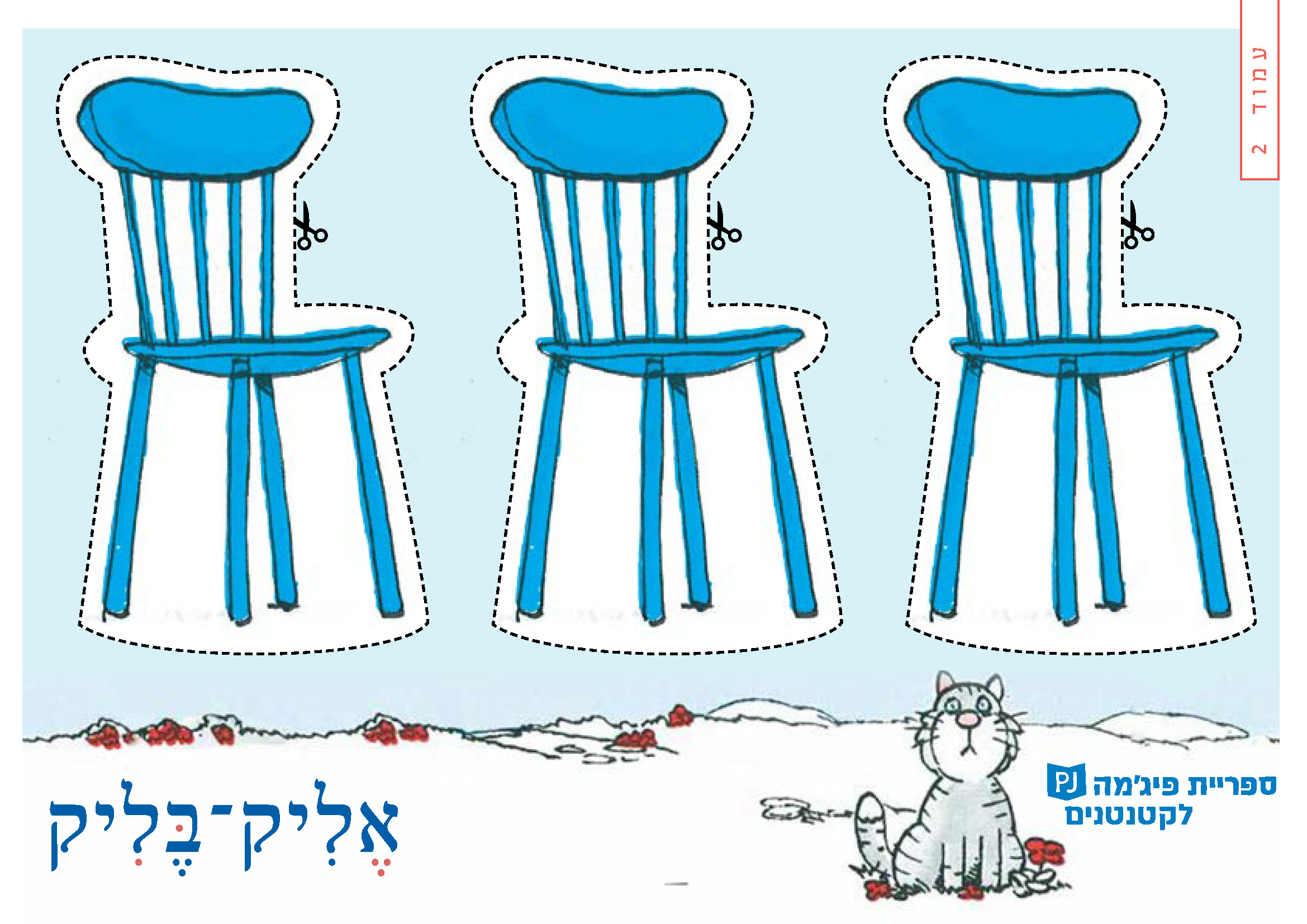
Reading Together
Do you also have little friends visiting your home? Are they imaginary friends, or maybe a beloved doll? It is worthwhile to talk about it with the toddlers and hear what do they like doing with the little friend. You can “bring in” the little friend to join and read the story.

How to Read the Story?
The story is slightly longer than usual, and in order to arouse interest and curiosity it is recommended telling it in a variety of voices: a voice for Dad, a voice for Yaeli and a different voice for Mom and for Elik Belik. You can look together at the illustrations and invite the toddlers to participate in the identification of details and repeat the words “Elik Belik”.

Hide and Seek
Where’s the doll? On the table? maybe underneath it? And where’s the ball? You can hide various objects, look for them and then say: “The ball is on the chair”, “The ball is under the bed”. You can also hide yourselves and look for each other.

From Small to Big
Dad has big shoes, Mom’s shoes – they are less big, Yaeli has little shoes, and Elik Belik’s? Tiny shoes! Go on a journey throughout the house, collect items of the same type and arrange them from the smallest to the biggest.
Reading and hugging
While reading a story, you can hug each time a new animal joins the group. You can also play the hugging game: move away from each other, count “three, four,” and then run to each other, and hug!
It’s crowded but that doesn’t matter!
Invite the rest of the family to sit together with you on the couch, on the carpet or on a mattress. You can also include dolls or pets. Sit close together, then further away, and check: how pleasant is the closeness?
What sound do I make?
How does a dog bark? How does a cat meow? and how does a cow moo? – Toddlers can join can join in to the animals in the story.
Would you like to bring another animal in? And what sound would that animal make?
Sing about cabbage
“I sat on a cabbage” is a song that you can sing, add movements to, dance to and clap your hands to.
The song will upload when you scan the code:
QR – I Sat On a Cabbage – Scan the code and sing together!
Words of emotion
The letters in the story describe feelings: missing someone, loving someone, feeling happy…
How about making some cards with words of emotion, as well as phrases that describe these emotions, and connecting each word with the sentence describing it?
Missing someone: I wish we could see each other again
Loving someone: It feels good when we’re together
Feeling happy: This tune makes me want to jump up and dance
Feeling thankful: I’m so glad we met! Thank you for coming round!
Having a party
Would you like to party like Rosalinda and Aaron? You could use the invitation they made to write an invitation of your own, prepare one of the dishes they had at their party, play some party music, and dance together.
You could even take some photos during your party, and save them in an envelope inside the book you’ve received.
Illustrations tell a story
The illustrations in this book demonstrate how Itamar and the rabbit imagined one another versus what they really look like. You may want to check and compare: Do the monsters resemble the real child and rabbit? Are there any similarities between the monsters both Itamar and the rabbit had imagined?
Discussion
Were you, parents, also afraid when you were younger? Perhaps you could tell your children what you were afraid of, and how you grappled with your fear. You could also listen to your children as they tell you what scares them, and together, think of ways to overcome the fear.
Pleased to meet you: Monster
What does a scary monster look like? How about drawing one together, and then trying to imagine: What is the monster’s name? Who are its friends? What does it enjoy doing, and what is it afraid of? Now that you’ve gotten to know the monster, it may be worth asking yourselves whether it is still as scary as it was before.
A family magic word
“Jimalaya Jim! Zuzu buzu Yam Pam Puzu!” Each of the characters in this book has a magic word it uses when something scary happens. What is your magic word? You’re welcome to chose a family magic word together, and think of times when it would be appropriate to use it.
Discussion
Who are your friends? What do you like doing together? You can have a conversation about this and look into these questions: Do you like sitting together with other people quietly, like the penguin? Perhaps you like running, like the tortoise? How about thinking together about how you can bring some joy to friends who need you.
What story do the pictures tell?
Through the unique drawings in the book, you can read the story together even on the pages that have no words. Look, together, at the pages with the drawings, and tell each other what those drawings are expressing. Is there an illustration that you liked in particular?
Hello, Red Balloon
Which drawings does the red balloon appear in? When does it disappear? You can look for it in the book, and play some games with balloons, too, like hitting a balloon between your hands, tossing it into the air and trying to prevent it from touching the floor, or inflating it , releasing the air, and seeing where it ends up.
Visiting the sick
Amos McGee takes care of his friends, and they take care of him when he’s sick. Think along with your children about how you can make a sick friend or relative happy (through a phone call, a hand-drawn card, a small gift, and more).
Pinterest – Arts and crafts suggestions on the book’s page in PJLibrary’s Pinterest account
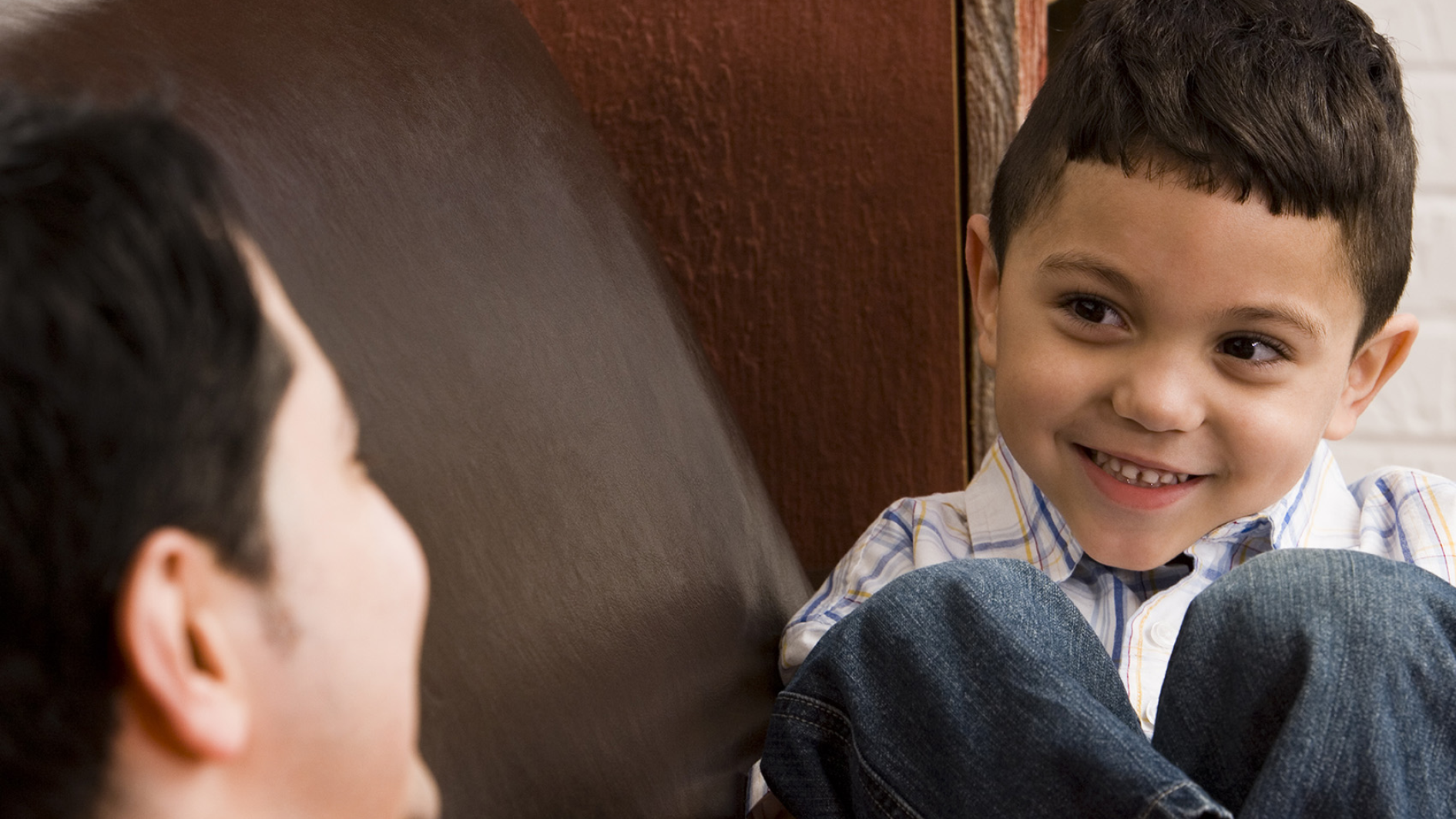
Discussion – With someone and on my own
What can we do on our own? What’s better done together? You may want to discuss the things we can do with others with your child, and then come up with the things that they can do themselves. Who do they enjoy sharing experiences with? Family members? Friends? Perhaps their pet?

A game – On one foot
Can you also stand on one foot? Let’s check!
Throw a die, stand on one foot and count to the number shown on the die: One, two, and… Are you about to fall? Reach out and allow whoever is next to you to help you stay upright.

Cooperation
You may enjoy putting a list together of all the activities that are best done together, in collaboration with someone: Tidying up your room, making dinner, or reading your favorite book. Then, take some cards, write each activity down on a separate one, and decorate it. You could keep all the cards in a special box, pick one out every day, and ask: How about cooperating today and sweeping the house? Why don’t we engage in a family game of catch? Or how about joining forces in some other activity?
Movement – On one foot or two
You may want to assemble a movement course at home, and complete it on one foot, two feet, all fours, or perhaps even three… Design a track on the floor using skipping rope, and take turns completing it in a different way each time: Hopping on one leg, while keeping a cushion balanced on top of your head, crawling, in pairs, with your arms crossed, because it’s easier to jump on one foot in pairs.

Pinterest – Movement games, collaborations, arts & crafts and songs are on the On One Foot page on the PJLibrary Pinterest.ּ
Discussion
This story prompts a discussion about neighbors and relationships: You may enjoy asking one another which neighbors you know, and come up with an activity that would help you get to know a family that lives nearby better. You, parents, are welcome to share stories about the neighbors living near your childhood home: Who were they, and what did you do together?
Pleased to meet you – Getting to know your neighbors
You could, perhaps, prepare something together to give to your neighbors: It could be something to eat, a drawing, or a letter that you could leave by the door. You could even just visit them and ask them how they are doing. And the simplest suggestion of all: Smile when you see your neighbors, and say: “Hi, how are you?” and “Have a great day!”
Fun at home
The characters in this book do lots of fun things at Yael’s house! You could look at the illustrations, choose an activity that interests you, and do it yourself, or with the rest of your family.
A home of your own
The children in this book make a building out of boxes. You can do the same! Find different-sized boxes and build a home from them for yourselves or your toys. Don’t forget to invite your neighbors over to visit!
Discussion – Parents ask "why?"
What sort of questions would you like to ask, and of whom? This may be an opportunity for both parents and children to share the questions that interest them the most. You could also raise questions that you would have liked to ask Shu the Vixen and Tut the Snail.
Being creative – The question box
What can we do with all the questions waiting to be answered? How about preparing a special question box, decorating it, and filling it with all the questions you find so intriguing. You could write them down on some notepaper and put them into the question box. Anytime you like, pick one, and look for the answer together.
Question games
Why at home? – Go around the house collecting “why?” questions about everything you encounter.
Questions about friendship – inspired by Tut and Shu’s friendship, you may enjoy asking: What do you think about Shu’s friends’ behavior? Has a friend of yours ever gone far away, or have you ever left a friend behind? Who were your parents’ friends when they were younger? What did they play or like to do together? What does your child like to do when their friends are around?
Questions about pictures – You may want to look at a picture together, and try to think of as many questions as you can to ask about it. You could then go out searching for the answers to your intriguing questions. You may even enjoy challenging yourselves, and looking for questions to an answer you already know: look at the picture (for instance: a gift, blue, moon), and instruct your child to think of a question to which this detail in the picture is the answer.
Proposed Family Activities:
- You may want to snuggle up and leaf through the illustrations together. You could ask your child to show you what Toto and La La are doing on each page. What kind of expression does Toto have on his face when La La refuses to share her bucket and spade with him? When are both friends smiling?
- Perhaps you could take some stuffed animals or puppets and act the story out together.
- At the end of the book, Toto and La La “party”. You may want to think of things that make you want to party, and how you enjoy partying with friends.
- Perhaps you would like to discuss the difference between personal items and those that belong to your entire family with your child. You could walk through the various rooms in your house, and identify those items that are “only mine”, such as a toothbrush, versus those who belong to the entire family, like the living room couch.
- Does your child enjoy playing with sand? You could do so at the beach, or even in your own garden or backyard. Use items found in every home along with your bucket and space: plastic boxes, sieves and strainers, spoons, funnels, etc.
- When friends come over, it is sometimes hard to share our toys with them. Perhaps you could decide in advance which toys to offer them, and which to keep aside. You may want to encourage your child to be kind to their friends when they come and visit, and share their games with them. You can later discuss the warm feeling you get when you make friends happy by sharing with them.
Proposed Family Activities:
- Pepper’s nose is blocked and he has a terrible cold (or as the Hebrew original puts it “betsudad dora”). Can you understand what he says? Try blocking your nose and reading Pepper’s dialog. You could also ask your child to translate “cold” into Hebrew, and invent new “cold” words.
- The story is long and suspenseful. You may want to pause at the point where Joezer announces “We’re in trouble”, let your child guess the rest of the plot, and resume reading another day.
- You could ask your child who, in their opinion, had invented the story – Jo or Pepper? You may also enjoy making up your own story, and taking turns to do so. Start the first sentence, then ask your child to add one of their own. Keep going, taking turns, until an entire story comes together. You could even write it up, and draw some illustrations to go along with it.
- Pepper (as well as Marheshvan) is a funny name for a bunny! Does your child know that the month of Heshvan is also called Mar-Heshvan? Mar is Aramaic for drop, and during the month of Heshvan we expect rainfall. Some say the word Mar was added to the name of this month because it is the only one in which we do not mark a single Jewish holiday or fast day. Can your child name all the Hebrew months of the year? You may want to check the Hebrew birthdays of all your family members, and create a Hebrew birthday calendar for the entire family.
- Are any of your child’s classmates unwell? Perhaps someone around you is feeling a little sick? You could think of ways of making them feel better together, like making them a hand-drawn greeting card, calling them, taking over something yummy, or properly visiting them, story and all!
Proposed Family Activities:
- You may want to snuggle up to each other and look at the illustrations together. What does Big Wolf do before Little Wolf comes along? Perhaps you could suggest that your child leaf through the book, and tell the story in their own words. You could also try to tell the story from Little Wolf’s perspective.
- You may want to ask your child to look for the illustrations in which Big Wolf helps Little Wolf. What does he do for his friend throughout the book? You could think of your friends together, and remember the little things you do for one another.
- You may enjoy tying two inner toilet paper rolls with some string to make binoculars. You could climb up a hill, and try to locate various objects using the binoculars you made. What is the furthest thing each of you was able to spot?
- When Big Wolf first sees Little Wolf, the latter is no more than a dot on the horizon. You may want to take a blank sheet of paper, and draw together – start off by making a small dot, then ask your child to add some detail to the picture, and keep on taking turns as you go along. What has your dot turned into?
- Big Wolf misses Little Wolf, and awaits his return. You may want to remind your child of a friend with whom they have not spent time recently, and suggest inviting them over.
Proposed Family Activities:
- You may want to act out the story using puppets, and invite each character to explain how they ended up being friends.
- There are two illustrations of the house in the final pages of the book. You may want to ask your child if they can spot the difference between them. What’s been added to the second illustration?
- Is there a teacup, piece of furniture, or photograph that’s been in your family for a long time? Perhaps there is an interesting story associated with this item. If so, you may enjoy sharing it with your child.
- Your child may like to draw your home and loved ones. Together, you can make a frame for their drawing, and hang it up on the wall.
- Have new neighbors come to your neighborhood recently? Perhaps you know new Olim who have arrived in Israel not too long ago? You may want to make a greeting card for them in the spirit of this book, and print the word “welcome!” on it.
- Where does your family originate from? Perhaps you could open an atlas, and show your child the journey made by your family on their way to Israel. You may want to tell your child about your own childhood home, and show them photographs of homes in which you have lived over the years.
Proposed Family Activities:
- You may want to snuggle up and look through the book together. Ask your child some of the following questions: did any of the illustrations make you smile or sad? Are you familiar with all the animals in the book? Do you think they all make suitable pets? Try to imagine being able to have an unusual pet: which one would you choose?
- We suggest taking a moment at the page on which the boy and his tiny elephant reach the pet club, and reading the sign out loud. You could discuss what, in your opinion, is the reason why elephants are not allowed into the club. How does that make the boy and his tiny elephant feel? Before you go on reading, you could perhaps hazard a guess as to what the boy would do next.
- How about making a model pet club from a shoebox, and acting the story out together using some puppets. You could enhance the story by making up conversations between characters.
- “Because that’s what friends do” – you may want to share a special friendship you had during your childhood with your child. What did you enjoy doing together? Which games did you play? Who are your child’s friends, and how do they like to spend their time together? Is there a boy or girl from kindergarten who has never been round to your house? Perhaps you could have a gathering of friends of all ages – because all are welcome to the family club!
- You may enjoy making a sign for your child’s bedroom together, and writing a welcoming greeting on it, such as “all are welcome here”, or “welcome, one and all”.
Enjoy reading and discussing the book together!
Proposed Family Activities:
- You may want to leaf through the book together, enjoy the colorful illustrations, and look for the various animals. Can your child name them all? Have you noticed who waits for the animals on the final page? You may enjoy making different animal sounds each time, and asking your child to look for its illustration in the book.
- Once you have read the story over several times, your child may be able to answer questions such as “how does a dove coo?”, or “how does a duck quack?”. You may also want to play a game: you could each make an animal sound, and ask the other to name the animal.
- Perhaps you would like to make simple puppets with which to act out the story. Take some old socks, stuff them with cotton wool, sew on a button for a nose, draw a pair of ears and eyes, and make any animal puppet you like – your very own mouse, snake, or turtle.
- You could play with stuffed or plastic animals, arranging them in pairs in a long line. Perhaps an old shoebox can be turned into Noah’s ark, sheltering the animals from the oncoming storm.
- Does your child also like to hold your hand when you’re out on the street together? How about this novel way of walking hand in hand: let your child place their feet on yours, now hold their hands, and walk together.
Proposed Family Activities:
- You may want to leaf through the book together, and look for all the animals: the hedgehog, rabbit, squirrel, and mouse. Have you discovered any other animals hiding in the woods?
- It may be advisable to read the story several times to allow your child to remember the sequence of events, and join you as you read the recurring lines: “רעבים ביער לא חסר, כדאי מאוד להסתתר” [“Many in the woods are hungry, it is best to hide”], and “התפוח גדול, אפשר גם לכבד” [“It’s a big apple, we can share it”].
- You may enjoy discussing moments in which we share with or give to others together. Remind your child how we host friends, share toys in kindergarten, or offer others some of our yummy snack.
- Each animal has a unique way of walking: the hedgehog takes small steps, the rabbit hops, the squirrel skips, and the mouse pitter patters. You could play charades together, imitating the various characters in the book: one of you does the imitation, while the other guesses which of the characters they are pretending to be.
- You may enjoy acting the story out using stuffed animals you have at home. You could also make animal costumes using old fabrics: cut various shaped ears, attach them to hair bands, and become hedgehogs, rabbits, squirrels, and mice.
- The friends in the book enjoy a meal together in which each of them gives and gets from the others. You may enjoy organizing a picnic with some friends or neighbors, in which each of you brings something from home, and shares it with the others.
- You could make a pinecone hedgehog with your child, and ask them to paint it with some paints and a paintbrush. Who will be the happy recipient of this colorful gift?
Proposed Family Activities:
- Have you noticed how the illustrator chose to depict the cat and rabbit as children in disguise? Does your child also like to play dress-up? You may want to put on some ears and tails and take a trip together.
- You may enjoy looking for the pages on which the cat and rabbit eat. What sounds do they make while eating? Try to listen to the sounds we make when we drink from a straw, have an ice-cream, or eat a crunchy apple.
- Perhaps you could act this story out using rabbit and cat puppets. You can use leftover fabrics or old socks to make your own.
- Do all of your family members like eating the same food? Which of you drink from a bottle, and which of you have hot coffee in a mug? You may want to suggest that your child try out new dishes every once in a while. Did they like them? Remember, there is no accounting for taste.
- You may enjoy inviting a new friend home, and finding an activity to do together that will make both friends happy: taking a walk, drawing, building something, or reading this book.
Proposed Family Activities:
- Perhaps you would enjoy taking a look at the illustrations together: can your child name all the shapes on every page? While reading the story, you may want to pay attention to the shapes’ facial expressions. When are they happy? And what makes them smile?
- You may enjoy using some colored paper to cut out shapes, or playing with a ready-made game of shapes. Together, you could invent other combinations of shapes, and create more things.
- Perhaps you would enjoy going on a search, and discovering the shapes that are hidden in books, toys, and various rooms of your home, such as the square floor tiles of your living room, or the round holes in your sieve.
- You may want to play with building blocks, and use the different shapes to create various artistic structures together. For although it is sometimes nice to be alone, it is so good and pleasant to play together!
- Does your child know the song Hinneh ma tov uma naim (“Behold, how good and how pleasant…”)? Perhaps you would enjoy singing it and dancing together.
- On the final page of the book, the shapes create a windmill together. Has your child ever seen a windmill? You may want to make a paper pinwheel, blow on it, and see how the rush of air moves its wings, just like a windmill.
Reading the illustrations
You may enjoy sitting comfortably, looking at the tender illustrations, and identifying the various ways in which Bear helps his friends. Perhaps you could ask your child to tell you the story by the sequence of illustrations, or imagine what story Bear was going to tell his friends before winter came along. You may also enjoy inventing another Bear story, and illustrating it together.
Acting the story out
You could act the story out using puppets and stuffed animals. Invite the rest of your family to watch the play!
Mutual help
Bear is a good friend, who realizes what his friends need, and helps them. You may want to remind one another how you have helped each other throughout the day. You could choose a family member, neighbor or kindergarten friend, and think together about something they may need a hand with, and how to lend it to them.
Oops, I forgot…
Have you ever forgotten what you wanted to say? You could play charades together. Try to remind one another of shared experiences using familiar songs, hand gestures, or drawings.
Help your toys get ready for winter
You may want to allocate a corner of your child’s bedroom to serve as a winter corner for their stuffed animals. Perhaps you would enjoy using pillows and blankets to make burrows or caves for comfy, cozy hibernation.
What's the story?
Bear turns his experience into a story to tell his friends. You may enjoy making a little book together entitled The Day we have had, and fill it with drawings of the experiences you had today. You could read the book together before bedtime.
Just one more story
Is your child always asking for one more story during bedtime? You could place a small box or basket by their bed, containing some of their favorite books, for your child to look at on their own after saying good night. You may want to go through the basket every once in a while, and select new books with which to fill it together.
Winter is coming
You may enjoy taking a walk in your neighborhood together, collecting colorful fallen leaves, and making prints out of them: place a piece of paper over a leaf, and color over it using red, orange and brown crayons. Hang your leaf prints around the house.
The illustrated story
You may have noticed that the illustrations tell a slightly different story than the text in this book. You may enjoy looking at the illustrations together, comparing the text and image on each page, and asking: what is happening in kindergarten while the boy tries to fly? Who is the fairy eating with, and who is the knight? Perhaps you could make up a new story based only on the illustrations. What are the differences between your story and the one you read in the book?
Dressing up as superheroes
Dressing up as superheroes: You may enjoy making a cape, wand or wings, just like the ones the boy and girl have in the book. You could act the story out, and head off on your own adventures. Perhaps a cat in the backyard, a crying infant, or someone in your family needs help? If you join forces with one another, you just might be able to “save” them.
Who saved whom?
Who saved whom? You may want to read the end of the story again. Who, in your opinion, saves whom? Have you ever helped a friend in need? Has anyone ever “saved” you? Maybe you would like to imagine the little girl meeting her parents at the end of the school day, and the conversation they might have. You, the little girl’s parents, might ask: “How was your day in kindergarten?”. Later you may enjoy thinking up a similar conversation between the boy and his parents.
Make-believe
Make-believe: Many children enjoy playing with superhero action figures, and imagining they too have super-powers. You could join them as they play, express an interest in the super-powers of your child’s favorite character, and let your imaginations run wild. If you also pretended to be superheroes when you were a child, you could share those memories with your child, and compare your childhood superheroes to today’s characters.
Sometimes alone, other times together
Sometimes alone, other times together: You may want to look through the book and find the times when the boy and girl prefer to be on their own, and the times when they enjoy playing with others. Perhaps you could share with one another: what sort of things do we enjoy doing on our own, and which do we prefer to do together? Following your talk, you may want to think of a new fried and invite them over to play at your house.
We are all superheroes
We are all superheroes: You may enjoy using your imagination together. You could think of various situations in which our imagination would help us in our everyday lives, and ask questions such as: “If I were as tall as a giraffe…”, “If I could fly high up in the sky…”, “If I could be in two places at once…”. You may want to draw these imaginary situations, and make a scrapbook entitled If I were a Superhero.
Proposed Family Activities:
- You may want to sit and leaf through the book together. Perhaps you would like to ask your child to look for the ten sailors in the illustrations, and try to identify each one using their description. Did you find any of the illustrations funny? You may want to ask your child to tell the story in their own words, according to the order of the illustrations.
- You may want to stop reading at the point where the fisherman sailor chooses to drill a hole in his cabin, and ask your child what they think will happen next. You could suggest that your child draw a picture of the ship filling up with water and fish.
- In the first few pages of the book, the sailors are depicted with a rope connecting them. What do you think binds the sailors together? What connects you to your family? You may want to tell your children about the expression “All the People of Israel are responsible for one another”, and think about how we each contribute to the wellbeing of others.
- Each sailor on the ship has a role to play, and each depends upon the others. You could take a large sheet of paper and draw a family drawing together in which each family member chooses just one color. In order to create a colorful drawing, the entire family must cooperate, each member using one color and coordinating their actions with all the others.
- What sort of story is created when the entire family writes it together, one part after the next? Probably a very amusing one. You may enjoy starting to write a story, stopping after one line, and letting other family members write the rest in turn, adding more directions, and letting the plot evolve.
- Perhaps you might like to put a jigsaw puzzle together as a family. Once you are done, take one piece out. What does the puzzle look like with one piece missing?
- Each of us can contribute to the growth or collapse of a building. You may enjoy playing with blocks, wooden bricks, or magnets, and building a tall tower together. Once it is up, try removing pieces from it without letting it collapse.
Enjoy reading and discussing the book together!
The following story was inspired by the Midrash in Leviticus Rabba 4:6:
The breathtaking illustrations add another level to the story
The breathtaking illustrations add another level to the story, and you may want to take a closer look at them. What is the fox doing on each page? How do the children’s facial expressions alter throughout the story? Have you also noticed how the pond changes as pages are turned? Perhaps you would like to select your favorite part of the book, and draw it whichever way you like.
pretending to be one of the children's parents
You may enjoy role-playing, pretending to be one of the children’s parents. It’s night-time, and the children return from the orchard in high spirits. Perhaps you could ask them how their day at the orchard had been, and let them describe their experiences in their own words.
Anything's possible when you use your imagination
Anything’s possible when you use your imagination: carobs become swords, olives turn into delicious salads, and half a pomegranate serves as a royal crown! You may want to play the following game: pick an item and pretend to do something with it using nothing but gestures, no speaking allowed. Your child should try to guess what the item has become, and think up other uses for it when they have. Take turns picking items and guessing.
Fighting and making up
Fighting and making up: after reading the story, you may want to discuss quarrels among friends, and share stories of fights and make-ups you have experienced. After fighting, each of the children in the book played on their own. You may wish to speak with your child about times when being alone is pleasant and desirable, and other times, when it is more fun to play together.
Do you have an orchard, vineyard or forest nearby?
Do you have an orchard, vineyard or forest nearby? You could take a walk in them together! Just like the children in the book, you could also pick olives, and squeeze oil out of them, play with carobs, or hide behind trees. You may also enjoy collecting leaves of all colors, and crushing them onto a sheet of paper when you return home. Discover the different color liquids that come out of them, and use them to paint naturally colored paintings.
Family Activities
- Perhaps you would like to look at Daniella Dekel London’s amusing illustrations, and use them to follow the plot. What do the animals like doing together? Did you find the three ants running away? Have you managed to identify the various animals concealed in Good Mood Bear?
- You may enjoy acting this story out together. Who can be the bear, and how will you disguise yourselves? And who will play the part of the other animals? At the end of the show, you could make some sandwiches and eat them together in a special friendly picnic.
- Many things can put you in a good mood: playing with friends, singing and dancing, or hugging. Perhaps you would like to discuss the various things that make you happy, and choose one that fills your heart with delight – like singing and dancing together, going for a walk in the neighborhood, or reading your favorite books together!
- The bear in the book makes new friends, and the group has a great time together. Following this story, you may want to invite a new friend home, and try out new things together. Have you made a new friend? Did spending time together put you in a good mood?
- “I’m bored and have no one to play with!” Just like the bear, we have all felt sad or bored at times, and do not always have friends around. You may enjoy preparing a “good mood kit” together: decorate a shoebox, and put little prizes in it, such as stickers, crayons, or small games. Keep the box hidden, and take it out when you’re lonely or bored.
- Perhaps you could make little bears from various items. What could you use for round ears? And how will you give it a chubby belly?
- You and your child can also dress up as bears, other animals, and even various family members. You may want to create a costume and prop basket, filled with various materials, hats, glasses, and household items. Dress up, guess each other’s costumes, and get in a good mood!
Perhaps you would like to observe the cats on your street.
Perhaps you would like to observe the cats on your street. How do they walk? What sounds do they make? What do they eat? Are they domesticated cats or street cats? You could place an empty cardboard box in the yard. Maybe a cat would use it to sleep in?
Activities You Can Do at Home
- Amy and Louis became friends because they were neighbors who enjoyed the same things, so when Amy moves far away, she’s faced with a big challenge. Talk with your children about how you manage to keep in touch with faraway friends and family. After you finish reading this story, your children might get in touch with people they miss: they could write or draw a letter to send them, or talk to them via phone or the Internet.
- Amy and Louie don’t merely miss each other; they recall the things they used to do together. You might talk with your children about things we can do to help keep memories alive. If you have photos, letters, or other items that remind you of friends and shared experiences from your past, you could share them with your children.
- Children are introduced to this book near the end of their kindergarten year. You could talk with your children about good-byes, transitions, and new beginnings. Maybe talk about the friends they’ve made in kindergarten and the things your children like to do with them. Your children could also draw pictures or write letters to give to a friend, teacher, or other staff member at the kindergarten, as a memento.
- Have you ever traveled to a foreign country, “half a world away?” Do you, like Amy and Louis, have friends who live in a faraway land? Using a globe or an atlas, you could show your children the countries you’ve visited or the places where your friends and family live. You could also explain time differences, intercontinental travel, and much more. “Amy and Louis” is the final book in PJ Library’s list for the year. We hope you have enjoyed these books and send you our best wishes for a successful summer and transition to kindergarten and beyond. Please keep in touch!
Activities You Can Do at Home
- Flip through the pages of the book together and ask your children to tell you the story in their own words, using the illustrations as guides.You may also choose dolls or stuffed animals to represent Aliza and her friends, and enact the story together.
- Everyone feels lazy at times. You can discuss this together: when do we find it hard to do things? Maybe it’s when we first get out of bed in the morning, or when we have to do chores we don’t like?
- Sometimes young children are actually mature enough to perform certain tasks by themselves, but they don’t do sobecause they’reaccustomed to getting help. You and your children could brainstorm about which tasks you tend to do for them—and then choose one task that they can now do all by themselves. Be sure to give them positive feedback when they show you how independent they can be!
- Who are Aliza the duck’s friends? Who are your children’s friends? And who are your friends? Think of the things that Aliza and her friends enjoy doing together, and then share how you spend time with your friends, and have your children tell you what they like to do with their own friends.
- You could bake a cake together and invite friends over for a tea party, just as Aliza the duck and her friends do at the end of the story.
- If you know the fable: “The Grasshopper and the Ant,” you could tell it to your children.
We hope you enjoy reading and discussing together this book!
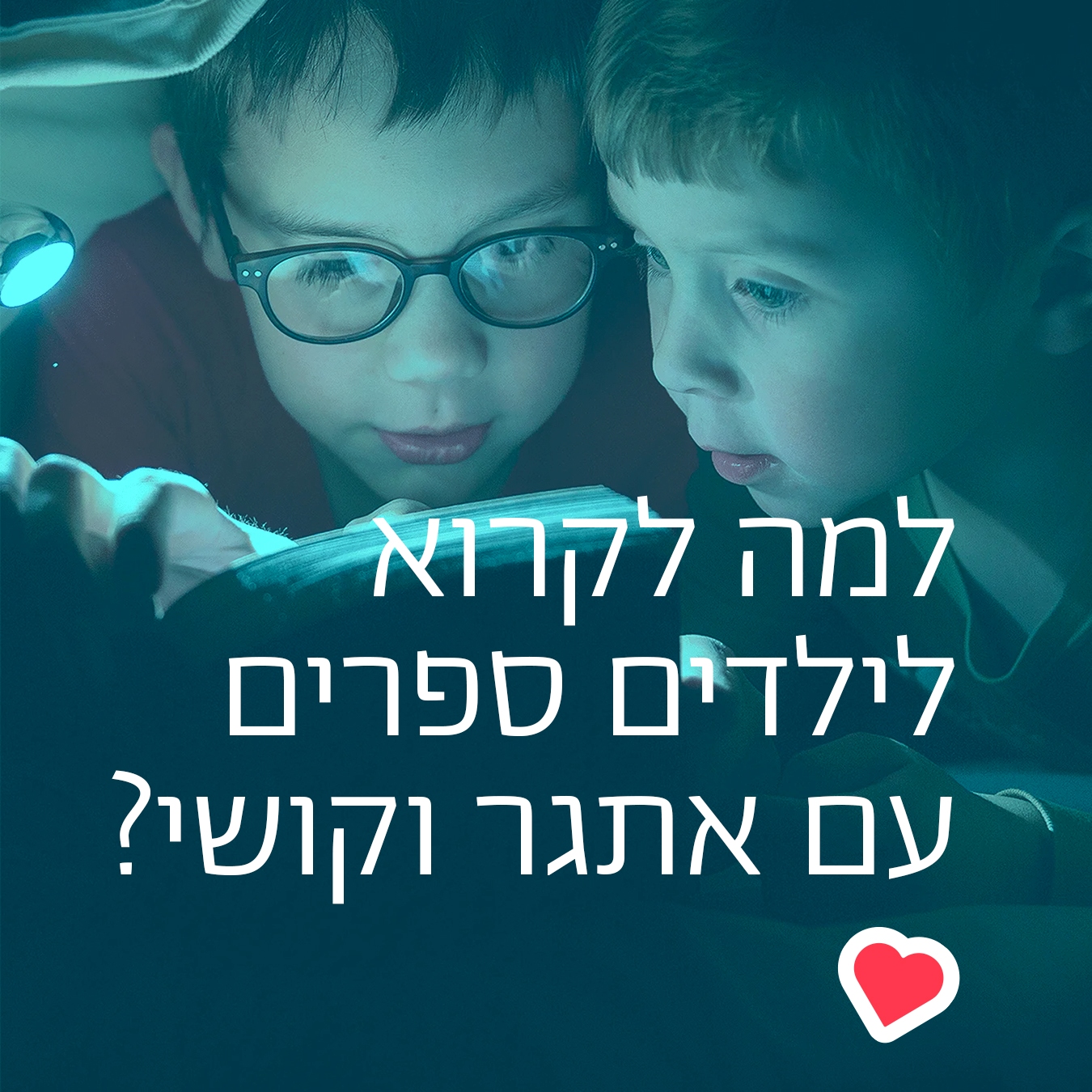
Suggested Family Activities
- It all began with a misunderstanding and hurt feelings, and then “Now you’ll see what’s going to happen!” After reading the story together you may discuss intentions and misunderstandings among friends, and share experiences with one another.
- Like Kramer the cat, we all feel big at times and small at other times. You can ask your children when they feel big and when they feel small, and talk about the advantages and disadvantages of each.
- “Scratches, bites, jumps and somersaults” – that’s how the author Meir Shalev describes cat games. You can flip through the book, select one of the animals and act out that animal’s movements.
- Kramer is very fearful of the large animals he meets in the forest. This can be an opportunity to discuss with your children caution and safety rules, fears, and ways to overcome fear.
- Kramer’s friends teach him an important lesson in friendship: A good friend is one who knows how to forgive and to apologize. You can look for the illustration where Kramer’s friends meet him in the forest, and note the expressions on their faces.
- Yossi Abulafia’s rich illustrations depict an array of animals – some domestic, others wild. You can look at the illustrations with your child and see how many of the animals you recognize. Does your child know all the animals’ names? Which of them can be found near your house? You can go for a hike. Which animals, large and small, do you meet on the way?
- You can act out the story using stuffed animals and toys. Allow your children to select the dolls to represent Kramer, his friends from the garden and the forest animals. The animals can be happy, be afraid, play together and quarrel – and, in the end, make amends and apologize.
- After reading the book together you can look at the picture of Kramer sleeping in his bed, choose a doll or stuffed animal and guide it to sleep by reading a “Sifriyat Pijama”
bedtime story.
A discussion on imagining together
Children love to play “make believe”. They enjoy pretending that they are grown up: “Driving” a car, making mud “cakes”, or playing with an imaginary friend. You can play this game with your child using a prop, such as a doll, pot, or toy car, and ask: Where are we going? What are we cooking together? What is the doll saying?
A Game of “Almost the Same”
Ron sees Shluli in the puddle, but, in fact, it is his own reflection in the water. You could also play a game of “mirror” in which two players face one another and take turns pulling a face, moving their head or leg, and having the other imitate them.

Family Activities:
- You might ask your children to flip through the pages and “read” the pictures to you in their own words. See if together you can discover all the things the illustrator added to the written text. Did you or your children find anything funny? Were there objects that your children did not recognize? You can ask them to point out the pictures that show the ant and the cricket helping one another. Then you can draw your own picture of the ant and the cricket, as you imagine them. Does your ant wear eyeglasses too?
- Go to the ant… consider her ways and be wise (Proverbs 6,6): Discuss with your children the characteristics of the ant and the cricket in the story. The ant is industrious and plans ahead, while the cricket sings and dances. After reading the story, you can talk about the different traits and tendencies of everyone in your family and note the distinct contribution of each member.
- Who are your neighbors? Do you help one another? After reading the story, you might think of a small act of kindness that you and your children can do for one of your neighbors. How does it make you feel? Have you, like the ant, ever felt that there are times when “it’s even better to give than to receive”?
- Are you acquainted with Aesop’s fable about the ant and the grasshopper? In that version, the ant refuses the grasshopper’s request for food. You can share the fable with your children and compare it with this story. Do you like one version more than the other? Why?
- “What goes around, comes around”: Sometimes children feel that family life is not fair, when they are asked to help out and their siblings are not. You can discuss how the ant responded to the cricket’s repeated requests for ingredients, and ask them how they think she felt after working hard and saving up all week. It is important to point out that in the end, the ant benefited by helping the cricket. This is often the case in families – there are many opportunities to help others and to be helped, each one according to his or her ability and to the circumstances.
- You too can bake a cake for Shabbat! It is fun to work together in the kitchen, and even more fun to share what you made with neighbors and family! You might want to invite some neighbors or friends over to eat your cake and sing songs with you, just like the ant and the cricket in the story.

Recipe for Orange Cake:
Ingredients:
150 grams butter or margarine
1 cup sugar
4 eggs, lightly beaten
1 tsp vanilla
Grated rind of two oranges
1 cup squeezed orange juice
2 1/2 cups flour
3 tsp baking powder
Powdered sugar for decoration
- Beat together the butter and sugar until smooth and fluffy.
- Add the beaten eggs, vanilla and orange rind and continue mixing.
- Add, alternating liquids with solids, the orange juice, flour and baking powder until smooth.
- Pour the batter into a lightly-greased cake pan and bake at low-medium heat (170 degrees) for 35-45 minutes.
- When completely cool, dust the cake with powdered sugar.
Bon appetite and shabbat shalom!
מבשלים פנקייקים עם רות סירקיס!
צפו במתכון המיוחד לפסח של רות סירקיס לפנקייקים! מתאים לכל ימי השנה!
Family Activities
The story of the three butterflies was first published in 1938, and has since accompanied many generations of Israeli children. Do you know of an earlier version of the book containing other illustrations? You may want to take a look together at Orit Bergman’s illustrations. Have you noticed that the butterflies’ wings are multicolored? You may like to consider why the illustrator chose to paint the butterflies this way.
The three butterflies look out for one another and refuse to be separated. You may want to discuss friendship and mutual obligation together, be it between friends or family members. Perhaps you’d like to share stories about your friends and your child’s, and the things you enjoy doing together. Following the story, you might want to ask your child if they or their friend had ever been prevented from joining in a game, how that made them feel and what they did in response.
The flowers are only willing to allow those who are of a similar color in. You may want to compare the illustrations of the flowers to those of the butterflies. What similarities and differences can you find between them? You may like to ask your child what they think of the flowers’ behavior.
You may also want to act the story out as a family by dressing up in the colors of the flowers and butterflies. You could also create a puppet theater, with characters for the butterflies and flowers, using popsicle sticks and cellophane.
You might enjoy going outside and looking for butterflies and flowers! Just like in the story, flowers and butterflies in nature differ from one another, each having their own particular color and shape. Have you come across a tulip or lily? How many types of butterflies have you found, and what color were they? Do you happen to know the name of any butterfly? Perhaps you’d like to mimic the way butterflies move, and invent the Butterfly Dance together.
Levin Kipnis wrote hundreds of well-loved children’s poems and stories that form an integral part of Israeli culture. You may wish to look for them at home, in kindergarten, or at the library, and read them together.
Levin Kipnis
Levin Kipnis was one of Hebrew children’s literature’s founding fathers. He wrote and translated many literary pieces for children, and also set up and managed the first children’s theater in Israel. In addition, Kipnis edited numerous journals, anthologies and text books.
He was born in the Ukraine in 1894 and immigrated to what would later become the State of Israel in 1913. He felt there were not enough holiday songs and stories in Hebrew suitable for young children, and proceeded to collaborate with generations of kindergarten teachers in Israel, compiling preschool curricula and authoring hundreds of children’s stories and poems. Among his songs for the Jewish Holidays are: Svivon Sov Sov Sov (“Spin Spin Spin, Dreidel”) for Hanukkah, Ani Purim (“I am Purim”) for Purim, and Saleinu Al Ktefeinu (“Our Baskets are upon our Shoulders”) for Shavuot. His literary pieces contain messages of helping and consideration of others, such as in the famous Eliezer Vehagezer (“Eliezer and the Carrot”), Hamitriya Hagdola shel Abba (“Daddy’s Big Umbrella”), and… Shloshet Haparparim (“The Three Butterflies”).
Levin Kipnis was a particularly prolific author, and won many awards, including the Israel Prize in 1978, and the Hans Christian Andersen Award in 1988. He passed away in 1990.

Activities to Do Together at Home:
- Notice the things Matan and Noah like to do together before they quarrel. Ask your children what they like to do with their friends, and when do they help one another?
- Examine Matan’s and Noah’s facial expressions in the illustrations. When do they look happy? When do they look sad, or angry?
- If Matan and Noah were friends of yours, what would you suggest that they do to prevent the quarrel from occurring, or to make up afterwards?
- Ask your children if anyone has ever helped them to make up with a friend after a quarrel. How would you want to be helped to make up after a quarrel? You could create a little book –write your own story and illustrate it together.
- You could brainstorm together and come up with an ad or slogan that promotes peace between people. Create a poster featuring your ad or slogan and hang it up in your home.
- The bridge that Elijah the carpenter built was made of boards and nails. Ask your children what bridges they know, and what are they made of? You could also build a bridge out of popsicle sticks or Lego blocks. After you finish building the bridge, you could use it to stage a play about the story, using dolls or Lego figures.
- Do you know the song, “The whole world is one narrow bridge”? If you do, you can sing it together with your children.
Family Activities
- Perhaps you could look for toys and stuffed animals at home, and use them to act the story out. You may want to keep the toys in a basket, and let your child continue acting the story out themselves.
- You might enjoy looking through the illustrations in the book together. You could take a look at the toy parade on its way to visit Rama. How are they supporting one another?
- You may want to ask your child who they think could use some medical attention aside from Rama. Shula the Doll is injured, her leg fell off a year ago… You may enjoy setting up a toy hospital: take all your “injured” dolls out of the closet, as well as the plastic toys that have lost their leg, or the soldiers who took a hit during playtime, and try to fix or “treat” them.
- Do you know anyone around you (a friend, neighbor, or relative) who is not well? You may want to think of ways ti make them happy together with your child, such as making them a get-well card, calling them up, sending them something yummy, or paying them a proper visit.
- You may want to look at the illustration depicting Rama lying in her bed, unwell but smiling following her toys’ visit. Do you think people who are sick feel better after their friends’ had been to visit them? You may like to tell your child about a visit you had made to a sick person, or one you received when you were unwell.
- Try thinking together – what happened then? What did Rama do once she was well again? What did she tell her toys? How did they welcome her back when she returned to play with them? You could use your own toys to act out the next scenes in the story.
Yemima Avidar-Tchernovitz (1909–1995)
Yemima Avidar-Tchernovitz (1909–1995)
Yemima Avidar-Tchernovitz was born in Lithuania, and immigrated to the Land of Israel when she was 12. She began writing when she was in her teens, and told her early stories to the children in the Tel Aviv kindergartens in which she taught. Her stories were first published in the weekly children’s magazine Davar Liyladim, and she also wrote radio skits, in which she also acted on the “youth corner” broadcasts. Generations of children and youth in Israel grew up reading the dozens of well-loved books she authored, among which are Muki is Angry with Mom, Stories for Nivi, Two Friends on the Road, Eight in Pursuit of One, and One of Ours. Yemima Avidar-Tchernovitz is a Zeev Prize laureate and was also awarded the Israel Prize for Children’s Literature.
Family Activities
- Uncle Aaron and the tractor work the land together: they pull, mow, plow, harrow, fertilize, reap, and tug. There are so many words by which to describe working in the field! You may want to look at the book’s illustrations together, and try to identify which type of work is being carried out in each one.
- You may like to look at Uncle Aaron’s face. Does he seem to be enjoying his work? What do you think he finds enjoyable? Had Uncle Aaron invited you to join him, which type of work would you have wanted to perform with him, and why?
- You could ask Grandpa, Grandma or an older friend to do something with your child that requires life experience and knowledge. For instance: cooking, creating or building something together, learning a song or a few words in a foreign language, or planting some flowers.
- The red tractor went through several “phases”: it worked the soil; served as a children’s toy; and finally drove the kids to fieldtrips. Do you have an item or object that is no longer useful? You may enjoy finding a new use for it together (a cracked bowl can serve as a flowerpot, old clothes can form a costume, etc.).
- Perhaps you would like to build a tractor together using materials you have at home: cardboard tubes, bottle caps, old boxes, etc. You could paint it the most suitable color for a tractor, and get to work!
Enjoy reading and discussing the book together!
Family Activities
- This story is a fairytale, a work of fiction that comes to life through magical illustrations. The illustrator chose to place the kingdom inside a book, and have the characters be children playing “pretend” – making up the story about the imaginary kingdom. You may enjoy making a paper crown, cardboard scepter, and glamorous cape using a tablecloth or large scarf, and act out the story together.
- Perhaps you’d like to invent your own imaginary kingdom: What would it contain? What would it be made of? Would it have a king or queen? Would it also be teeny-tiny? You could write a story about your kingdom, or draw it.
- My own private palace: Using a simple, large cardboard box, you could create your own teeny-tiny kingdom. You could cut out doors and windows, and add (by drawing or using other accessories) towers and drawbridges to nyour heart’s content. Small toys can serve as king, advisors, and subjects. Who would you like to invite into your palace?
- The king chose to “change the rules of the game”: he stepped down, and left the comfort of palace life to win a friend. You may want to discuss your child’s friends with them. What sort of effort does your child put into their friendships? What do they like to do with their friends? Have they ever given anything up in order to stay friends with someone? You could share your own friendship experiences with your child.
- A kind deed for a friend: This story is full of longing. The subject misses his friend, the advisor misses the king… and the king misses his advisor… Do you also have a friend of the family or distant relative whom you miss? Perhaps you would like to send them a letter, e-mail, or picture by phone, or anything else that might make them happy. It could be a reminder of your true friendship, one that can overcome the physical distance between you.
- Do you know any other tales of kings and queens, princes and princesses? Perhaps you would enjoy inviting a friend over and reading those stories together.
Family Activities
- Throughout the book, illustrator Liora Grossman has depicted each of the objects lost by the characters in the story. You may want to look through it together, and search for all the missing items. Have you found them all? Have you ever looked for something and realized it was hiding “right under your nose”?
- Page by page, Aviv meets a tractor, princess, cloud and clown that claim “It’s mine!”, but none give all the signs describing the ball that he had found. You may want to play a similar guessing game: one player closes their eyes, while the other chooses a small object, hides it behind their back, and describes it using some identifying features. The first player then opens their eyes and tries to guess which object is being described and concealed.
- How can we refrain from losing things that are important to us? Ask your child to offer some ideas about how to take care of their property, and share some tips with them on how you make sure you don’t lose yours.
- Have you or your child ever lost something you loved? How did you feel? Have you found a lost object? Perhaps you too will have the privilege of returning it to its rightful owner! You may want to make a ‘lost object’ poster with a description of what you have found, along with your telephone number. You could go out on the street together and put the poster up in a public place. If anyone calls, don’t forget to ask them for signs to make sure you indeed return the object to its rightful owner.
- At the end of the story, Aviv and Yuval play ball together. You too can to play ball – passing it to one another, trying to shoot hoops, or kicking it toward the goal… just make sure you don’t lose it!
Do you know the tune to this song?
You can sing it together. You may want to put your fingers together as if you were pinching salt to form duck heads, and use your forearms as their necks.
קישור לשיר
enjoy hiding games
The illustrator, Raaya Karas, developed a search theme in her illustrations. You may wish to flip through the pages of the book with your child and notice where Grandma was looking for the ducks. Just like in the song, you could enjoy hiding games – peekaboo, hiding various objects around the room, and of course – hide-and-seek in or outside the house.
be reminded of more finger-play songs
This is a good opportunity to be reminded of more finger-play songs such as This Little Piggy, Itsy-Bitsy Spider and the Hebrew Grandma made Porridge (Savta Bishla Daysa) and I have Ten Fingers (Esser Etzba’ot Li Yesh). These involve tickling and bouncing on one’s knees. Do you remember the songs you were sung to as a child? Or songs in other languages?
Has your child seen a real duck?
Has your child seen a real duck? When visiting the zoo or looking at picture-books, you may become familiar with various types of ducks, and enjoy comparing them to the illustrations in this book. What makes them similar? What makes them different? What color are they? Are their necks long too?

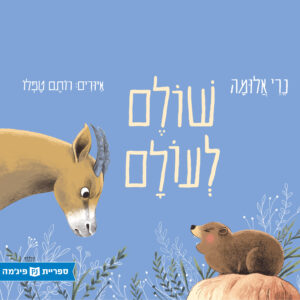 Peace to the World
Peace to the World 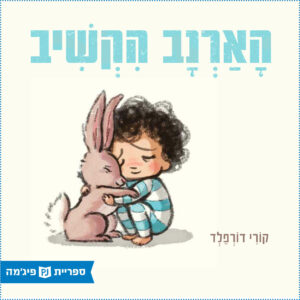 The Rabbit Listened
The Rabbit Listened 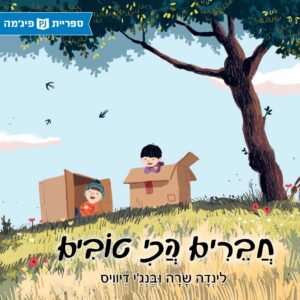 Best Friends
Best Friends 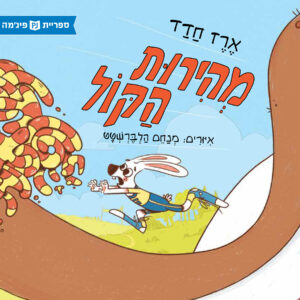 The Speed of Sound
The Speed of Sound 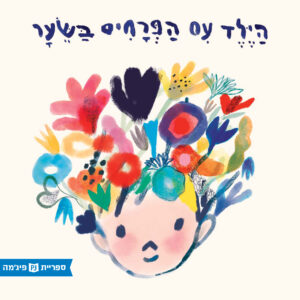 The Boy with Flowers in His Hair
The Boy with Flowers in His Hair 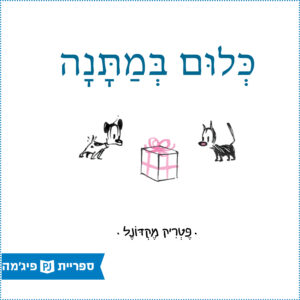 The Gift of Nothing
The Gift of Nothing 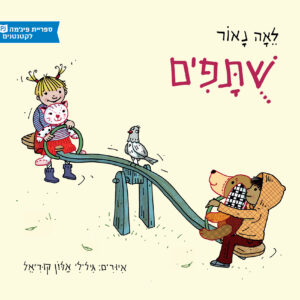 Partners
Partners 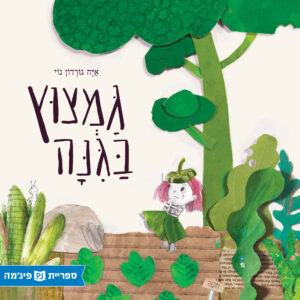 Morchella in the Garden
Morchella in the Garden 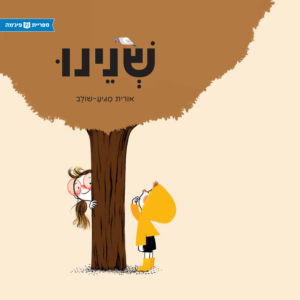 The Two of Us
The Two of Us 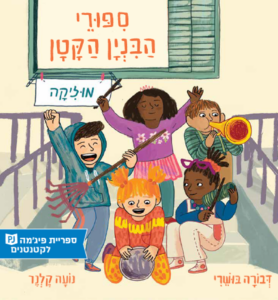 Music
Music 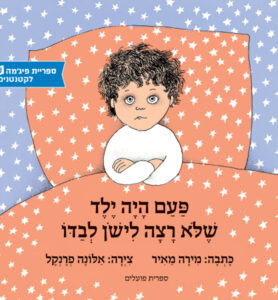 The Boy Who Wouldn’t Sleep Alone
The Boy Who Wouldn’t Sleep Alone 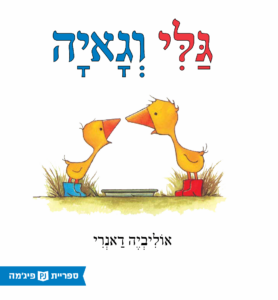 Gali & Gaya (Originally: Gossie & Gertie)
Gali & Gaya (Originally: Gossie & Gertie) 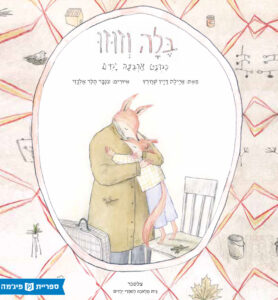 Bella and Zouzou
Bella and Zouzou 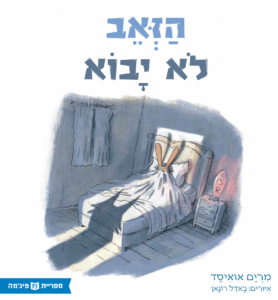 The Wolf Will not Come
The Wolf Will not Come 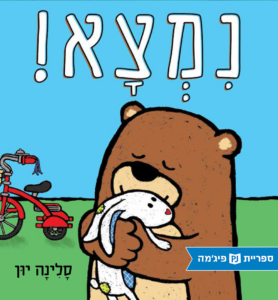 Found
Found 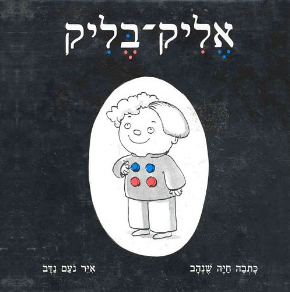 Elik Belik
Elik Belik 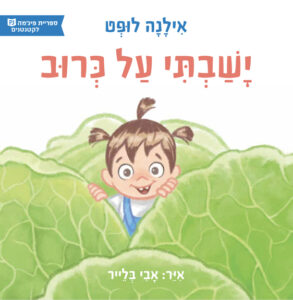 I Sat On a Cabbage
I Sat On a Cabbage 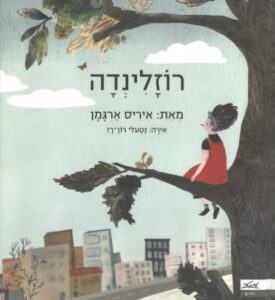 Rosalinda
Rosalinda 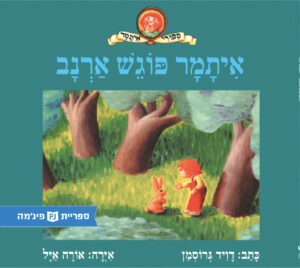 Itamar Meets a Rabbit
Itamar Meets a Rabbit 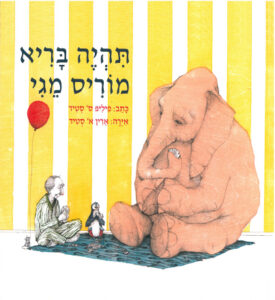 A Sick Day for Amos McGee
A Sick Day for Amos McGee 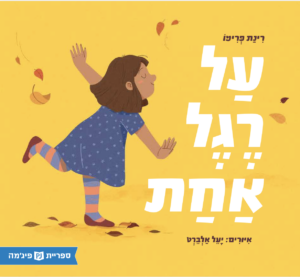 On One Foot
On One Foot 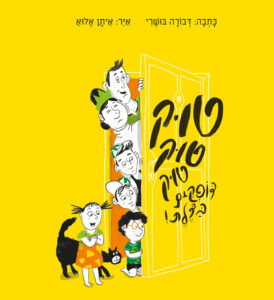 Knock Knock Knock – Knocking on the Door!
Knock Knock Knock – Knocking on the Door! 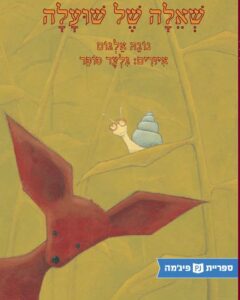 Why Not?
Why Not? 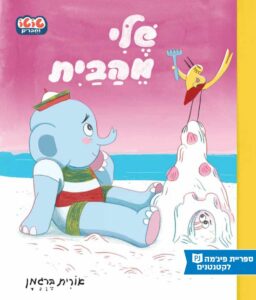 Toto & Friends: Mine!
Toto & Friends: Mine! 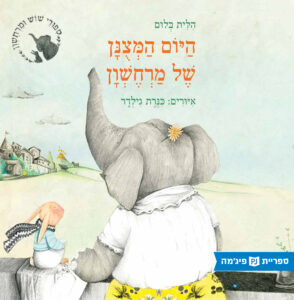 Jo and Pepper and the Big Sleep
Jo and Pepper and the Big Sleep 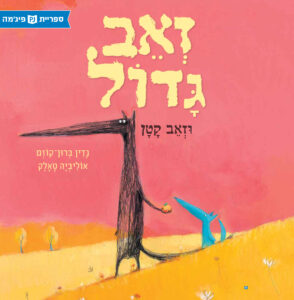 Big Wolf and Little Wolf
Big Wolf and Little Wolf 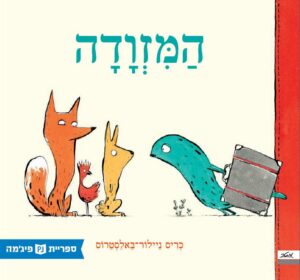 The Suitcase
The Suitcase 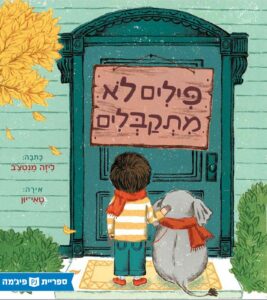 Strictly No Elephants
Strictly No Elephants 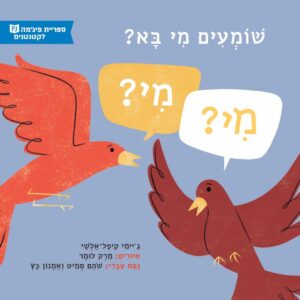 Can You Hear a Coo Coo?
Can You Hear a Coo Coo? 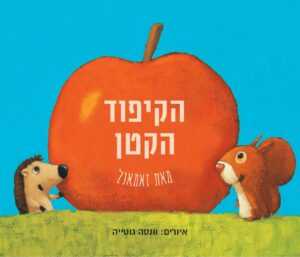 Little Hedgehog
Little Hedgehog  A Rabbit and a Cat are going on a Trip
A Rabbit and a Cat are going on a Trip 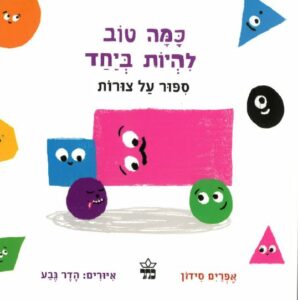 Friendly Shapes
Friendly Shapes 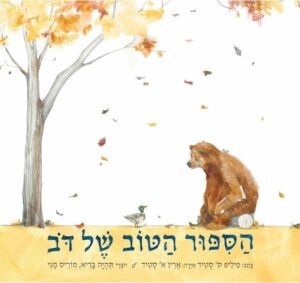 Bear has a Story to Tell
Bear has a Story to Tell 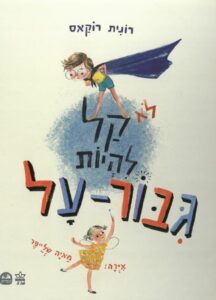 It’s not Easy to be a Super Hero
It’s not Easy to be a Super Hero 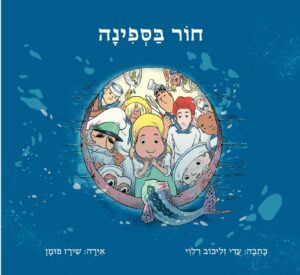 A Hole in the Ship
A Hole in the Ship 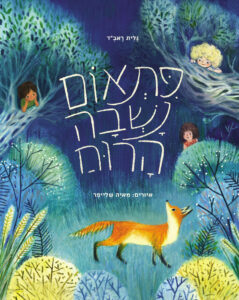 At the Heart of the Orchard
At the Heart of the Orchard 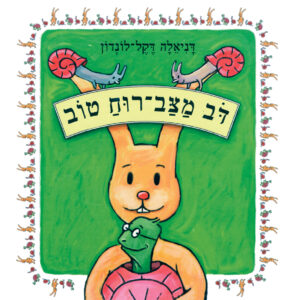 Good Mood Bear
Good Mood Bear 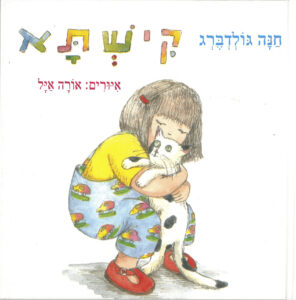 Kishta
Kishta 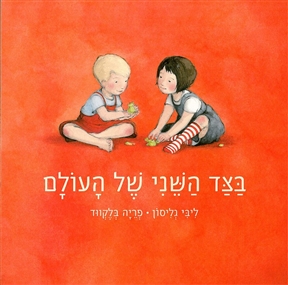 Amy and Louis Hebrew title: “Half A World Away”
Amy and Louis Hebrew title: “Half A World Away” 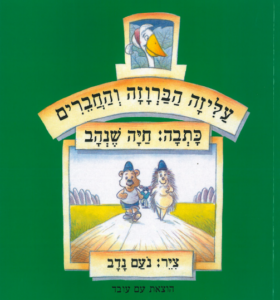 Aliza the Duck and Friends
Aliza the Duck and Friends 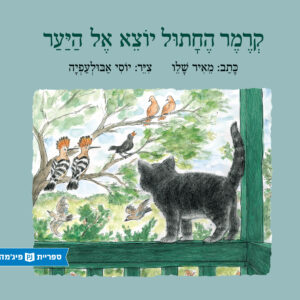 Kramer the Cat Goes into the Forest
Kramer the Cat Goes into the Forest 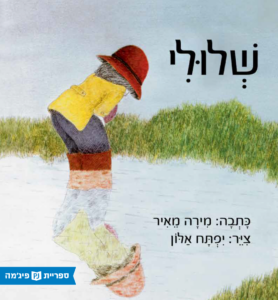 Sheluli
Sheluli 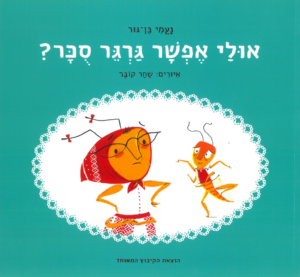 Can you Spare a Spot of Sugar
Can you Spare a Spot of Sugar 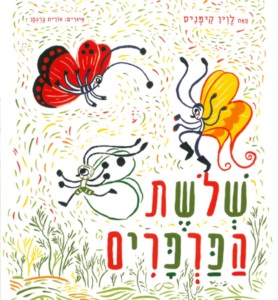 The Three Butterflies
The Three Butterflies 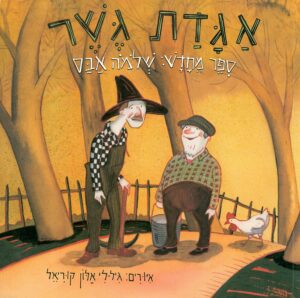 The Bridge Tale
The Bridge Tale 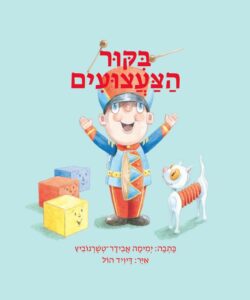 The Toys’ Visit
The Toys’ Visit 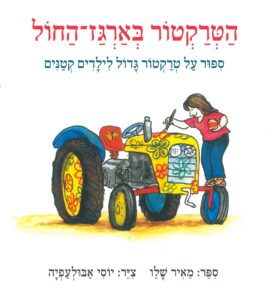 The Tractor in the Sandbox
The Tractor in the Sandbox 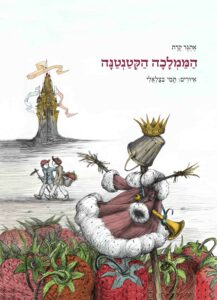 The Teeny-Tiny Kingdom
The Teeny-Tiny Kingdom 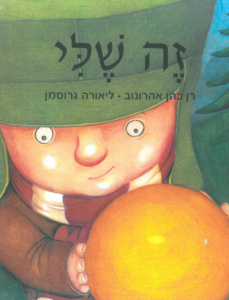 It’s Mine
It’s Mine 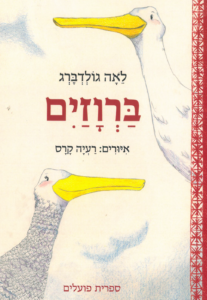 Two Ducks
Two Ducks 






